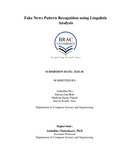Fake news pattern recognition using linguistic analysis
Abstract
The upsurge of fake news in social media calls attention to the erosion of long-standing institutional defense against misinformation in this Digital Age. In the wake of the 2016 Presidential Election in US, where social media played a crucial role in swinging votes, fake news has been a subject of increased discussion and debate. Social media used for news consumption has both its perks and disadvantages. In one hand it is relatively inexpensive and can be easily accessed but at the same time the likelihood of falling prey to fake news cannot also be disregarded. In this paper, we initially examine some of the existing technologies and frameworks that have been adopted to augment humans to make better decisions when it comes to recognizing news deception. We perform veracity assessment; conduct a comprehensive linguistic analysis on tweets to extract bag-of-words to perform Classification, specially structured around a specific target, in an attempt to find noticeable pattern in reliable and untrustworthy news. We discuss several surveys that have been undertaken in the past to help us present a comprehensive review of detecting fake news on social media. We later turn to the discussion of interconnected research domains and future research directions for constructing an ideal model for fake news detection system around social media. Although designing a fake news detector is not a straightforward problem, we propose a head-down operational guideline for a feasible fake news detecting system from a linguistic perspective. Keywords - Deception, detection, social media, news verification, Bag of Words, linguistic analysis, semantic analysis, recognition, pattern, graph.

